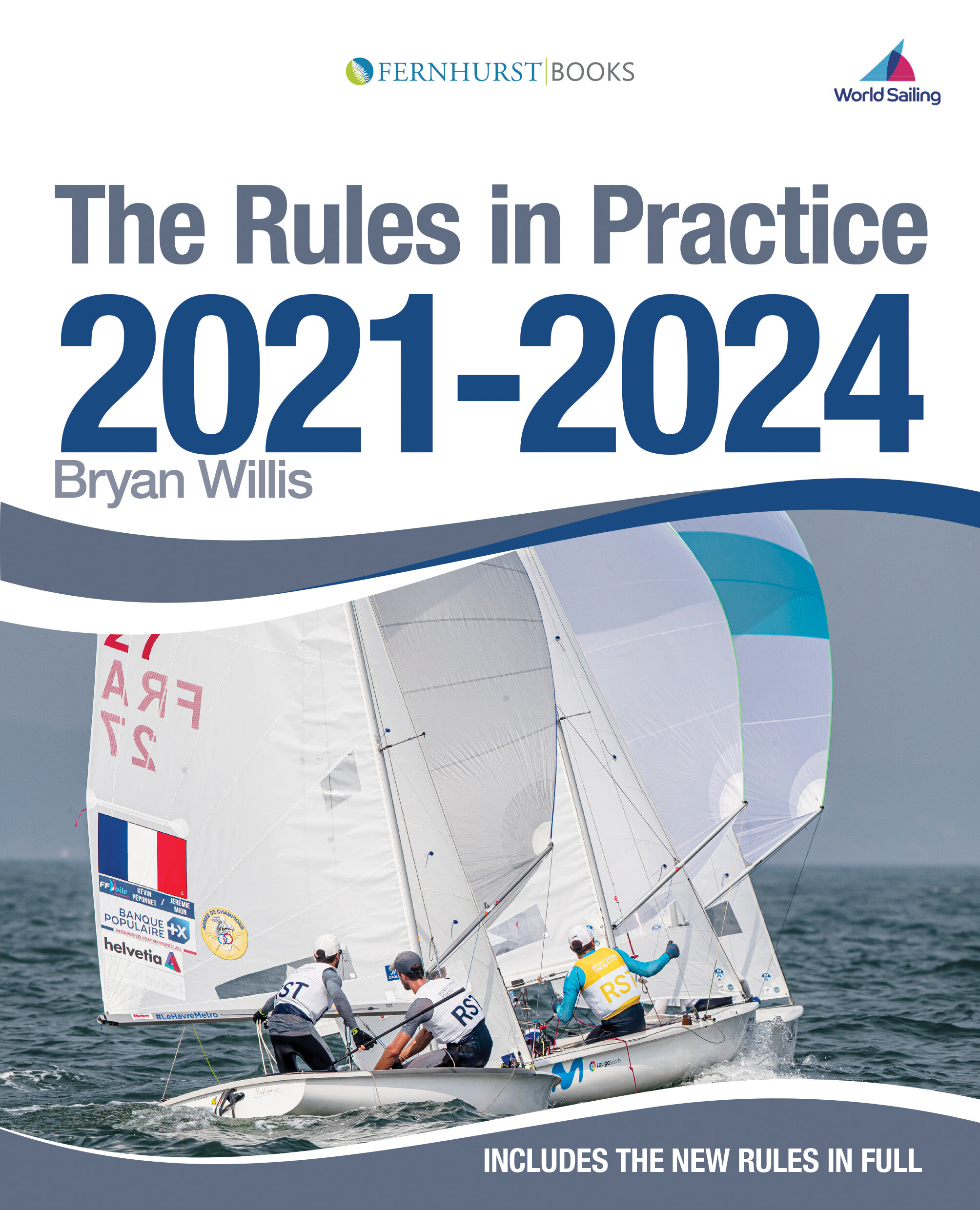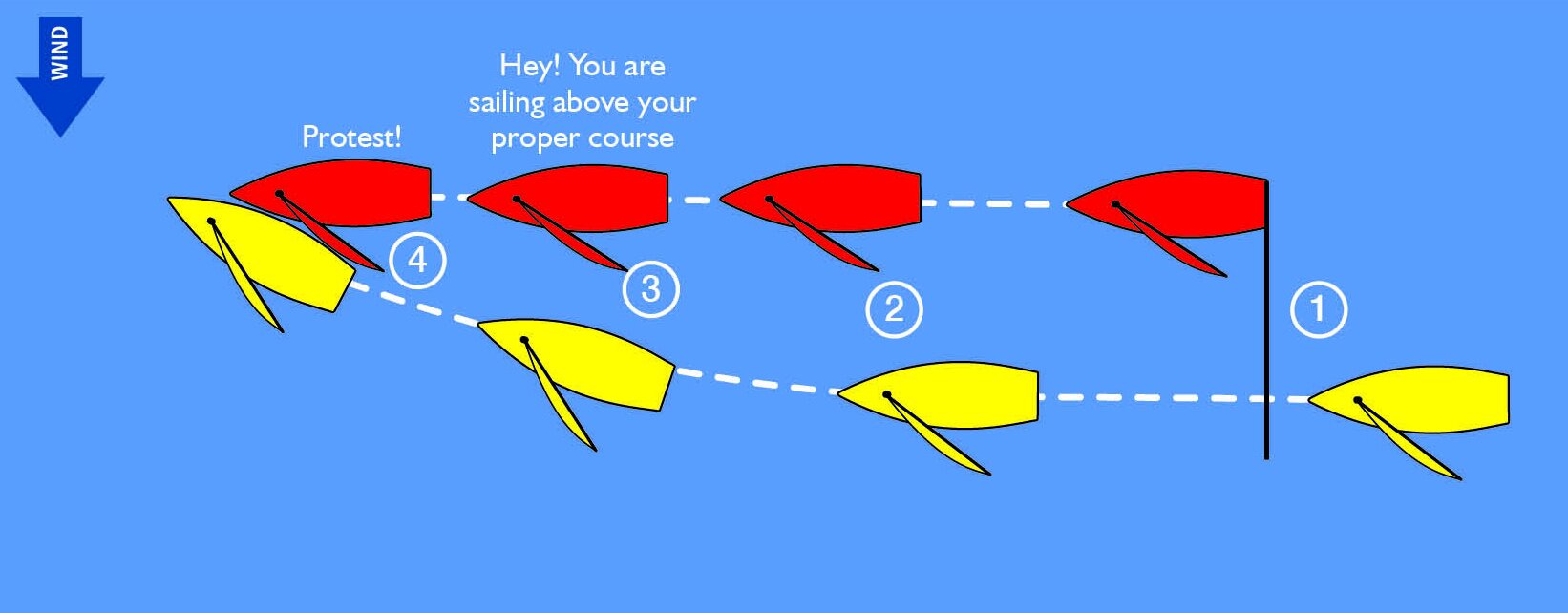The Rules in Practice - Fernhurst Books
EXTRACT FROM THE RULES IN PRACTICE 2021-2024
From the brand-new chapter: Luffing a boat to windward & keeping clear
Luffing rights (i.e. the right to sail above proper course)
A leeward boat has luffing rights (the right to sail above her proper course) unless she established an overlap from clear astern, within two of her hull lengths to leeward of the windward boat.
All the leeward boats (YELLOW) except GREEN have luffing rights (i.e. may sail above their proper course).
Avoiding contact
Before the beginning of this century, one could not describe the sport of sailboat racing (or ‘yacht racing’ as it was called then) as a ‘non-contact’ sport. Overtaking a boat on her windward side was a perilous activity.
In those days, after the starting signal, a leeward boat with luffing rights could ‘luff as she pleases’, even with the intention of making contact with the windward boat, and even if that resulted in damage. Only if there was serious damage or injury could the leeward boat be penalized (in addition to the windward boat for not keeping clear).
The idea was to make it imprudent for the overtaking boat to overtake close to windward for fear of the leeward boat luffing and crashing into the windward boat possibly causing damage, with little risk to the leeward boat. The windward boat would have to retire (or in latter years take a penalty). Instead the overtaking boat would sail some distance to windward or take the ‘safe’ route to leeward, through the other boat’s wind shadow.
Nowadays, sailboat racing is (thank goodness, if you have a classic yacht or any boat you treasure) a ‘no contact’ sport. However, the rules concerning a leeward boat luffing a windward boat are not easy to grasp. Many protests result from this manoeuvre and, when an incident results in a protest, the protest committee decisions vary. A good protest committee’s decision can surprise the leeward right-of-way boat.
What can happen is that the leeward boat (YELLOW) starts a slow but continuous luff, and the windward boat (RED) does a slow and continuous responding luff to keep clear. Eventually they reach a position at which if they both continue there will be contact. If this happens YELLOW will have broken rule 16.1 (for changing course but not giving room to RED to keep clear) and RED will have broken rule 11 but will be exonerated because she was forced to break rule 11 by the leeward boat (YELLOW) breaking rule 16.1. In a protest, only YELLOW will be penalized.
If the windward boat is carrying a spinnaker, she can get to a position where she cannot luff any more without getting her spinnaker tangled in the rigging. To keep clear in a seamanlike way, she must lower her spinnaker, and to lower her spinnaker safely she needs to bear away. Must the luffing leeward boat bear away to give her that room? Yes, if she wants to pursue this tactic, she must.
These sorts of tactics are not common in fleet racing because both boats lose in relation to the rest of the fleet. They are common in Match Racing and Team Racing. But even in fleet racing you can have a situation in the last race where one competitor doesn’t need a good result (because it will be his discard) but simply needs to drive his rival down the fleet to prevent him getting a good result. This is how Ben Ainslie won his Laser gold medal at the Sydney 2000 Olympics.
Before the start
· At position 1, YELLOW is clear astern of RED. YELLOW is the keep-clear boat and RED is the right-of-way boat.
· Just after position 1, YELLOW establishes an overlap. Now YELLOW is the right-of-way boat and RED is the keep-clear boat.
· As YELLOW has just acquired right-of-way, she is required to initially give RED room to keep clear. With more than a hull-length between them, YELLOW fulfils that obligation. After a few seconds, the obligation to give room fades away.
· When YELLOW establishes the overlap, RED is required to take action to keep clear. She could sheet in her sail and luff. There are no boats close to windward of her, so she is not prevented from fulfilling her obligation to keep clear.
· At position 2 RED by now should have sheeted in and luffed or done something to keep clear, even if she is forced over the start line.
· At position 3 there is contact but no damage.
· RED breaks rule 11 (windward to keep clear of leeward) and rule 14 (avoiding contact). YELLOW cannot break rule 16 (giving a boat room to keep clear when changing course) because she doesn’t change course, and because there is no damage or injury, she is exonerated for not avoiding contact.
Soon after position 1, YELLOW establishes an overlap to leeward of RED and becomes the right-of-way boat. RED must keep clear. There is no proper course before the starting signal, so YELLOW may luff as high as she likes right up to head to wind, provided that while altering course, she gives room to RED to keep clear.
However, when the start is signalled at position 3, YELLOW must promptly bear away to her proper course (or lower, if that is what she needs to do to gain sufficient speed to un-stall the keel / centreboard prior to coming up to close-hauled).
The diagram shows no infringements; YELLOW gave RED room to keep clear, and RED kept clear.
If YELLOW believes she was on the pre-start side of the line at the start (and therefore started correctly), then she must bear away to close-hauled (or a little below and then back up to close-hauled if that is how she would recover her speed). RED remains the keep-clear boat and as much as she would like to bear away to return to the pre-start side, she will have to slow and bear away behind YELLOW (or tack).
If, on the other hand, YELLOW knows she was over the line at the start, then her proper course is to bear away to a course that will get her hull onto the pre-start side of the line as soon as possible, so that she can start. Immediately after the start signal, she must bear off to that proper course.
Sailing the course
It might be the case that the leeward boat (YELLOW in the diagram) is sailing above her proper course without luffing rights, but even if she is, if you are the windward boat (RED) you must keep clear. If RED believes YELLOW is breaking a rule, she should protest. If the protest is successful and the protest committee is satisfied that YELLOW didn’t have the right to sail above her proper course, and that she was sailing above her proper course, then she will be penalized. But if RED doesn’t keep clear and there was nothing to windward of her preventing her from keeping clear, and YELLOW did not deprive RED of room to keep clear (e.g. by luffing quickly), then RED too will be penalized.
The windward boat (RED) may bear away to try to take YELLOW’S wind. There are no restrictions on the course RED may steer provided she keeps clear. In this scenario, RED has sailed down to ‘sit on’ YELLOW but she has got so close that if YELLOW were to bear away, she would immediately make contact.
The definition of keeping clear includes the phrase ‘A boat keeps clear of a right-of-way boat… when the boats are overlapped if the right-of-way boat can… change course in both directions without immediately making contact’.
RED has broken rule 11. YELLOW has not changed course and so 16.1 does not apply. There is no contact, so rule 14 does not apply. In a protest, only RED would be penalized.
This extract is taken from The Rules in Practice 2021-2024, the best-selling rules book from Fernhurst Books (who sponsor the Laser Class in the UK). It has been fully updated for the new rules which come into place on 1st January 2021, highlights the changes that have been made and contains the Racing rules of sailing in full.
The book is unique in that it is written from the sailors’ point of view, taking you around the course and describing how the rules apply in common situations, rather than taking you around the rule book.
It can be ordered here: https://fernhurstbooks.com/books/permalink/160/rules_in_practice_20212024
People who sign up for the Fernhurst Books’ newsletter can get 25% off their first order.







